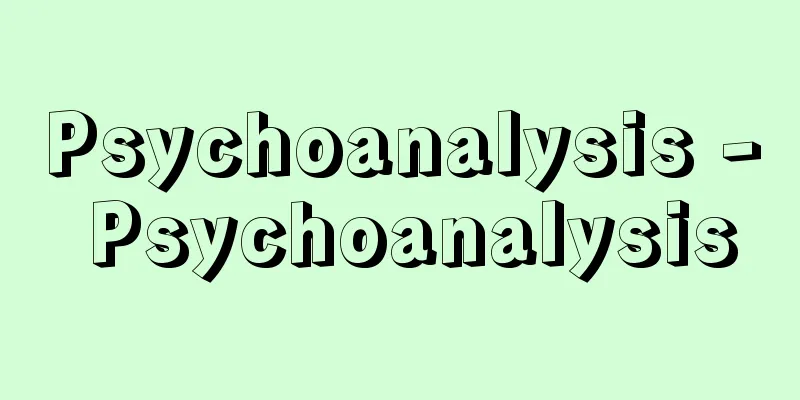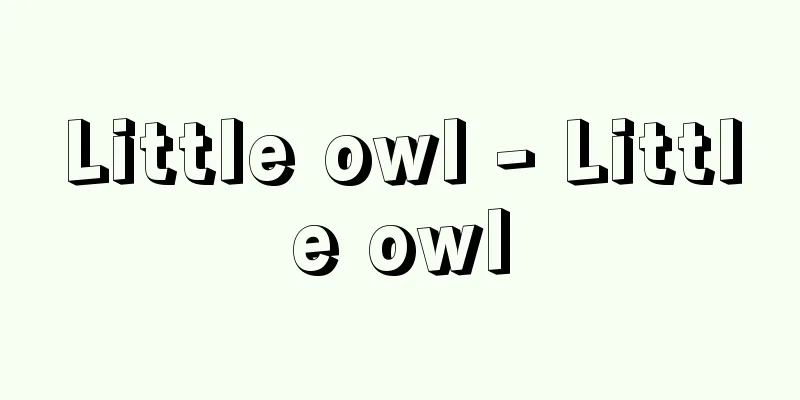Psychoanalysis - Psychoanalysis

|
Founded by S. Freud at the end of the 19th century, it is a theory of the mind, particularly the unconscious, a method of observing and elucidating pathology, and a method of treatment. Its practice ran parallel to the certification and specialized training of psychoanalysts, centered around the International Psychoanalytic Society, and in the 20th century, it was influenced by it and led to the development of psychoanalytic psychotherapy and dynamic psychiatry, which sought to make broad use of the knowledge of psychoanalysis, and cultural theory, art theory, and humanistic understanding also deepened. [Until the Establishment of Psychoanalysis] If we trace its origins back to before Freud, we can point to the work of healers, who had played a specialized role in unconscious therapeutic manipulation all over the world since ancient times. For example, in the ancient Greek temple of Asclepius, which was dedicated to medical care and treatment, there were priests who performed psychological medical procedures. Then, in the 1800s, Mesmer, FA, proposed the efficacy of animal magnetism, which permeates the celestial bodies and is a source of vitality and energy, and treated patients, contributing to the development of hypnosis, and his name became the origin of the English word "mesmerize." In 1881, after Freud qualified as a doctor and went to study in Paris, neurologist Charcot, JM, hypnotized hysterical patients to make their symptoms disappear or appear, but they were beginning to realize the existence of a deep psychology behind treatment through hypnosis and suggestion. [Early Development of Freudian Psychoanalysis] Meanwhile, Breuer, J., an internist who later became Freud's collaborator, discovered that the symptoms of hysterical patients improved if they were allowed to speak freely under hypnosis. Freud became convinced that the process of separation between the conscious and unconscious mind was not specific to neurosis but was widespread, and he believed that neurotic symptoms were the emergence of unconscious forces that could not find expression in any other way. He believed that a traumatic event was behind the symptoms, and as a treatment based on the psychopathological understanding of trauma, he attempted to make it conscious and bring about the release of emotions known as catharsis, which led to the birth of psychoanalysis. Among these various attempts, the method changed from an induction method such as hypnosis to free association, in which the patient lies on a couch and verbalizes the various thoughts that come to mind without selecting them. At that time, patients met in one-hour sessions six times a week; today, the International Psychoanalytic Association defines a treatment structure of at least four times a week. In this frequent analytic setting, various metapsychological concepts were born and experiences and understandings developed. [Middle development of Freudian psychoanalysis] Psychoanalysis is the psychology of the unconscious, and is called metapsychology, which is different from conscious psychology. The unconscious is used in the everyday sense, and descriptively in the everyday sense of "eating up unconsciously," and the indicator of repression is that it is usually forbidden to be conscious of it. However, Freud believed that the problem was not a memory of a real event, but rather a fantasy, so he abandoned the trauma theory and emphasized the mechanism by which internal desires, impulses, and drives (which were translated into German as Trieb and English as instinct, but are now commonly translated as drive) emerge from external events. In "The Interpretation of Dreams," published in 1900, the process by which unconscious desires are expressed and dreams are formed is presented with examples, including his own, and he argued that while instinctual desires seek direct expression, conflicts are created between reality and ideals, and the manifest dream is born, disguised by censorship and compromise through repression and defense. In a model generally known as topographical, a map of the mind is drawn that distinguishes between the conscious, preconscious, and unconscious as mental apparatus. The preconscious is said to exist between the conscious and unconscious (this depiction is almost a dichotomy, and corresponds to the positioning of the mind in Japanese as the front and the back, which can also be understood as the inside of the mind, the depths of the mind, the corner of the mind, or the darkness of the mind). The impulses, drives, and unconsciousness that are considered problematic have their basis in the body and biological elements. From the perspective of the mind, which is said to be economical, the sexual energy that drives them was expressed as libido. As shown in the analysis of wit and jokes, the purpose of effective expressions that provoke laughter is to save energy, and through that saving, the purpose is to feel relieved. Later, he also placed emphasis on aggression in relation to sexual energy, and this perspective had a great influence on the Kleinian school that followed. The dichotomy that is characteristic of Freud's thinking can be seen everywhere, with illogical unconscious thinking being the primary process, while conscious thinking functions according to a realistic and logical secondary process. Also, unconscious impulses and desires follow the pleasure principle, while conscious systems function according to the reality principle. There is an objective external reality in contrast to the subjective internal reality or mental reality, and the mind lives both. As a result, the two incompatible principles create an irreconcilable situation, and the mind is inevitably required to resolve it. A typical example of what creates this type of conflict is ambivalence, a mental phenomenon in which incompatible emotions or attitudes are directed toward the same object, such as love and hate. The next most important viewpoint is the developmental or embryological viewpoint, which holds that all psychic phenomena originate in the past, and that early prototypes determine later forms. And that earlier forms can still be active even when covered by later forms. This is explained by the concept of fixation, which means that an earlier psychic form remains, and the clinical concept of regression, which means that what has developed reverts to the past. In psychoanalytic therapy, the individual past of the analysand is reconstructed and abstracted, and an average temporal developmental diagram is created, which is important for clinical analytical understanding. The developmental model presented by Freud is psychosexual developmental theory, which depicts stages such as the oral stage, anal stage, phallic stage, Oedipus stage, or pregenital and genital stages, and this was widely shared until the Kleinian school, which emphasized the earliest development, and infant studies, which conducted child analysis and objective observations, presented a new understanding of infants. Furthermore, a dramatic point of view is a perspective that depicts the mind by developing stories and characters like a play. From this perspective, there is an interpretation method that uses myths and folk tales shared as a culture as archetypes of people's lives, childhood, and family stories, and Freud made use of this in his understanding of the Oedipus complex. In Greek mythology, Oedipus Rex is a man who killed his father and married his mother, and it is argued that this is the universal psychology of boys who love their mother and hate their father. In the case of girls, the basic situation is a family love triangle in which the mother is viewed as a rival and the father is desired to monopolize, but since both boys and girls have an inherent tendency toward bisexuality, both heterosexual and homosexual love triangles are possible. The analysis of transference discovered by Freud is based on the understanding that such relationships and unconscious fantasies are repeated together with the analyst, and culturally shared stories are also used in interpreting the scripts of individual lives. An example of the dramatic perspective is the concept of acting out, which Freud used in his treatment reports on hysterical patients. If we reconsider this concept of acting out as a translation, we should note that the German word "agieren" and its English translation "acting out" have both meanings, "to act" and "to perform," but the latter meaning was not translated into Japanese. Furthermore, the English translation emphasized "out," which is more likely to mean an expression outside the treatment room, and came to mean undesirable or short-sighted behavior. Thus, the term "acting-in" was even introduced to emphasize the message and therapeutic significance of behavior and acting directed at the analyst. Furthermore, Freud's idea that narcissism (which is sometimes treated as the same as self-love), named after Greek mythology, does not cause transference due to its pathology, was corrected by his successors. Furthermore, the dynamic perspective in psychoanalysis is a perspective that understands behavior through unconscious motives, drives, conflicts, anxieties, and guilt that are repressed in the background and deep within. In particular, Freud's understanding of unconscious guilt through self-analysis is at the core of psychoanalysis, but this guilt caused his own phobia of train travel, which he suffered for about 12 years until it was resolved. In his biography, The Life and Works of Sigmund Freud (1961), Jones, E., explains that through self-analysis, he came to understand that this was ultimately linked to the fear of losing his mother's breast and was an infantile panic of hunger. Specifically, this could be traced back to the influence of his jealousy towards his younger brother Julius, who died when he was 1 year and 7 months old, and traces of this remained in his later life in the form of anxiety about whether he would make it to the train on time. However, no matter how deeply he deepened his self-understanding, this repetition of brotherly conflict was difficult to resolve. According to the recollections of Ferenczi, S., one of Freud's students, Freud fainted and collapsed in Bremen in 1909, just before the two of them, including his arch rival Jung, CG, were about to depart for America, after a small victory over Jung. In Munich in 1912, Freud also fainted when he criticized Jung. Jung, who eventually broke off his relationship with Freud, was about 20 years younger than Freud, and expressed the view that all his fainting attacks were caused by jealousy over his dead brother Julius. Freud's fainting was due to the success and anxiety he felt after defeating his enemy, Jung, and was a mild case of the type of person who was affected by the guilt that accompanied victory, which he described as "people who are ruined by success." For Freud, the first event in his success or victory was the wish for death for his younger brother, which he had wished for and which was fulfilled, and he was aware that this had become an unconscious guilt that had been tormenting him. Freud, who competed with and tried to eliminate his rivals who disagreed with him, and defended the important idea of psychoanalysis while winning, seems to have overcome his sibling conflict as the "eldest son" in his later years. As shown in this example of self-analysis, psychoanalysis is characterized by its technique of verbalization, which "makes the unconscious conscious" through linguistic interpretation, and what is gained from this is called insight. In addition, the past (childhood) is emphasized as the period when the "script of the mind" is determined, and the analyst reconstructs the past based on recollection through free association. [Late development of Freud's psychoanalysis] In 1923, Freud introduced the structural model that is widely known as psychoanalysis. It showed the mind divided into three parts: the id, the ego, and the super-ego. The word Es means the vague everyday word "it" in German, but in English it is taken from the Latin id (meaning it), and in Japanese it is still written in katakana. The id is governed by the pleasure principle and functions according to the primary process, while the ego must simultaneously respond to the demands of the id and reality for the sake of self-preservation, and acquire various defense mechanisms such as repression and sublimation to make this possible. The super-ego develops in conjunction with the infant's identification with authority figures such as parents, and includes the role of "conscience" in everyday language. The ego must mediate, arbitrate, and "negotiate" between the id, superego, and reality, but symptoms and problematic behaviors are unpleasant and inappropriate, but are the inevitable result of compromise and failure. Such neurotic conflict resolution and compromise mediation extend not only to symptoms and personality formation, but also to cultural phenomena, the birth of works of art, and the choice of loved ones. [Development after Freud] Modern psychoanalysis is said to be divided into four groups: ego psychology, the Kleinian school, object relations theory or the British independent school, the intermediate school, and self psychology. Freud's daughter Anna Freud's book Ego and the mechanisms of defense (1936) drew attention to the defense functions of the normal mind, and clarified defenses against internal and external crises. Hartmann published Ego psychology and the problems of adaptation (1939), claiming that there are many areas that develop innately and function normally, including one that he called the conflict-free sphere of the ego. Psychoanalytic psychology that focuses on autonomously developing normal functions and emphasizes the pathology of ego functions is called ego psychology. While the Kleinian school has subtle differences among scholars as to whether it is the center of object relations theory, there is no doubt that it had a major impact on the development of object relations theory. Klein, M., who constructed a profound psychoanalysis that goes beyond the narrow definition of object relations theory, thoroughly followed the Freudian line of observing how neuroses originating in early childhood are born from the infant's internal impulses and fantasies. According to her view, objects are born from drives, and the early reality for infants is filled with phantasies and is delusional. Objects, like the hallucinatory wish fulfillment of Freud's theory, are created from drives, and people in the real world are receptacles for the projection of these internal object images, and the drives of infants living in fantasies already have knowledge of objects in the sense that they target something. Unconscious fantasies that develop against internal objects are the mental expression of instinctual desires, and external objects provide an opportunity for external expression as receptacles for projection. One of Klein's valuable contributions was to challenge Freud's idea of an objectless state, that is, narcissism, which loves the self rather than the object. In response to the idea that mentally ill or seriously ill patients regress to an objectless state, Klein presented the understanding that even patients who appear to have no interest in the outside world may be in the midst of an intense relationship with an internal object, or that the outside world is a receptacle of internal fear, and advocated the establishment of a relationship between the inside and the outside and thorough linguistic analysis. Another difference from Freud's theory is that while Freud's object is a relatively simple target of instinctual drives, Klein's relationship with it is variously, complexly, and sometimes bizarrely colored by fantasies, emotions, anxieties, and defenses. In this context, in Klein's theory, where aggression is emphasized, the "death instinct," which was somewhat speculative for Freud, is something that infants can live out in their fantasies from an early age, along with the "life instinct." The infant is ambivalent toward the object, and the ego has a relationship with the object that is divided into good and bad, i.e., good and bad breasts. This state in which a loving relationship and a hateful relationship are divided is called the paranoid-schizoid position (PS). When these two extreme partial relationships move toward integration, the state is called the depressive position (D), and guilt is experienced in the psychological friction that accompanies this. The fate of the two object relations, the good breast-ego and the bad breast-ego, which are the object split into parts, the good breast and the bad breast, in PS, and the guilt of "harming the one I love" in D, which recognizes that the two breasts belong to the whole object that is the mother, has influenced most contemporary object relations theories. Object relations theory in the narrow sense was founded by Fairbairn, WRD, who emphasized that the state of the human mind is not pleasure-seeking but object-seeking. One of the main conclusions he reached was that the ego, which develops from the stage of primitive identification in which the ego merges with the object, incorporates the object, and identifies with it, and then moves toward independence, has the potential to be a whole self from the beginning, but is unable to maintain this wholeness in a firm form from the beginning, and therefore splits or divides in response to various bad objects and relationships. Thus, in Fairbairn's description, the ego is depicted as a schizoid structure that lives in a dualistic object relationship between inside and outside, good and bad, in which the ego consciously relates to ``good'' external objects, but unconsciously relates to bad internal objects. He also believed that the ego splits to create this basic endopsychic situation, and that the splitting of the ego is the basis of all psychopathology. Furthermore, in the reading of DW Winnicott, who belongs to the same intermediate or independent school, what Klein regards as the inside is seen as a relationship mediated by a subjective object in an undifferentiated state between inside and outside. He then requires his own terminology to position it as an inner experience dependent on the external environment, which he calls "transition" and "intermediate zone." The therapeutic relationship that is the focus of attention in Kohut's self psychology is called narcissistic transference, which requires the analyst to accept and empathize with the patient, and the analyst, who is idealized because the patient is narcissistic, cannot fully empathize with the patient. Therefore, the fragile disillusionment is an issue, as in Winnicott's. Also, commentators who emphasize intersubjectivity have come from this trend. As mentioned above, there are many schools of thought within psychoanalysis. There were many instances when close younger brothers had conflicts with Freud and left. Adler, A. left, advocating individual psychology, and Jung, who was a very close friend, broke away and established analytical psychology. Furthermore, Horney, K., Fromm, E., Sullivan, H.S. and others, mainly in the United States, criticized the classical libido theory and emphasized cultural and social aspects, and became independent as neo-Freudians. In recent years, this latter movement has been trying to integrate with psychoanalysis through an approach to object relations theory as relational theory. Erikson, E.H., who rewrote psychoanalytic development theory using the concept of identity to reflect the American zeitgeist of the 1960s, also published a developmental theory that influenced general psychology. Furthermore, in recent therapeutic theories, attention is being focused not on the question of the origins of human repetition as something from the past, but rather on the repetition of relationships and defenses in the "here and now," with emphasis placed on weaving, developing, and understanding the therapeutic relationship, examining defenses, and leading to a "new relationship." [Influence of Psychoanalysis] Psychoanalysis is the only school of clinical psychology with a history of more than 100 years. The influence of psychoanalysis has also had an immeasurable impact on developmental psychology and personality psychology, but the analytical and clinical attitude of telling life as a story and thinking about it is probably the basis of clinical psychology in Japan as well. In addition, with the development of video equipment, a large amount of objective data on infants and young children has been obtained, and Bowlby, J.'s attachment theory and Mahler, M.'s theory of separation-individuation are widely known in the field of psychology in terms of empirical research. However, there are schools of thought that do not acknowledge the existence of the unconscious as psychoanalyzed, and the darkness of the unconscious is difficult to be the subject of research, and is sometimes shunned by positivist thinking. Therefore, behaviorist clinical psychology, which only focuses on observable behavior, and Rogers, CR, who established a client-centered, humanistic psychology, both started out by criticizing psychoanalysis. In addition, Freud himself showed psychoanalytic interest in various phenomena and continued to provide analytical commentary from the perspective of the psychology of the unconscious to specialists and general readers, and accordingly, 20th century psychoanalysis contributed to the understanding of groups, society, politics, religion, culture, art, and human beings themselves. Psychoanalysis, which uses verbalization as a method, has been criticized for being ambiguous in its preference for Japanese people to speak vaguely about what is deep in their hearts, but even if Japanese people prefer to remain silent in public, saying that it is better not to say anything of importance, they tend to be talkative if a trusting relationship is established in a comfortable interview room. This is why psychoanalytic psychotherapy is mainly conducted once a week in Japan, and the perspective of clinical Japanese language that emphasizes the Japanese language and Japanese culture, such as Heisaku Furusawa, Takeo Doi, Keigo Okonogi, and Shigeharu Maeda, has also achieved great results. →Attachment theory →Consciousness →Conflict →Complex →Ego psychology →Psychoanalytic therapy →Object relations theory →Analytical psychology →Defense mechanisms →Unconscious →Drives [Osamu Kitayama] Latest Sources Psychology Encyclopedia Latest Psychology Encyclopedia About Information |
|
19世紀末にフロイトFreud,S.によって創始された,心とくに無意識の理論であり,その病理の観察・解明方法であり,治療方法である。その実践は国際精神分析協会を中心にした精神分析家psychoanalystの資格認定や専門的訓練と並行し,20世紀になると,その影響を受けて精神分析の知見を広く生かそうとする精神分析的精神療法・心理療法や力動的精神医学も発展し,文化論・芸術論や人間学的理解もまた深化した。 【精神分析成立まで】 フロイトより前のその起源をたどるなら,無意識の治療的操作としては,世界各地に古くより専門的な役割を果たしていたヒーリング能力者(ヒーラー)たちの仕事が挙げられよう。たとえば,古代ギリシアの医療と治療のためのアスクレピオス神殿には,心理的な医療行為を行なう神官たちがいたという。そして1800年代になるとメスメルMesmer,F.A.は,天体に充満し生気と活力の源泉となる動物磁気animal magnetismの効能を提唱して患者を治療し催眠術の発展に寄与して,メスメルの名前は英語の「mesmerize(催眠をかける)」の由来となった。フロイトが1881年,医師資格を取って留学したパリでは,神経学者のシャルコーCharcot,J.M.がヒステリー患者に催眠をかけて症状を消したり出現させたりしていたが,催眠と暗示による治療の背後にある深層心理の存在に彼らは気づきつつあった。 【フロイト精神分析の発展 初期】 一方,後にフロイトの共同研究者となった内科医ブロイアーBreuer,J.は,催眠下で自由にしゃべることが許されればヒステリー患者の症状が良くなることを発見していた。そしてフロイトは,心の意識と無意識との乖離の過程は神経症に特有のものではなく広く発生するものであることを確信するようになり,神経症症状とは,他の方法では表現を見いだせない無意識的な力が突出したものだと考えた。そして,外傷的な出来事が症状の背後にあると考え,精神病理学的理解である外傷trauma(トラウマ)に基づいた治療として,それを意識化させてカタルシスcatharsisという感情の発散をもたらす試みが精神分析の誕生につながったのである。そのさまざまな試みの中で,催眠術のような誘導法ではなく,寝椅子に横になり心に浮かぶさまざまな考えを選択することなく言語化するという自由連想法free associationへと変化していく。当時の患者は,週に6回,1時間のセッションを繰り返していたが,現在では週に4回以上が国際精神分析協会の定める治療構造であり,そういう頻度の高い分析的設定でさまざまな超心理学的(メタサイコロジカル)な概念が誕生し体験と理解は発展していった。 【フロイト精神分析の発展 中期】 精神分析は無意識の心理学であり,意識心理学とは別のメタサイコロジーとよばれる。無意識とは日常的に,そして記述的に「無意識に食べ尽くす」というように日常的な意味でも使われ,普通は意識することが禁止されているのが抑圧repressionの指標である。しかし問題が現実にあった出来事の記憶ではなく,むしろ空想上の話であると考えたフロイトは,外傷説を放棄し外的出来事から内的願望や衝動,および欲動(独語でTrieb,英語ではinstinctと訳され混乱したが,現在は英語のdriveが定訳とされる)が表に現われてくるメカニズムを強調した。1900年に刊行された『夢判断』においては,無意識的願望が表出され夢が形成される過程が自らのものを含む実例とともに提示され,本能的な願望は直接的な表現を求めながら,現実や理想との間で葛藤conflictが生み出されて,抑圧や防衛の力による検閲や妥協によって偽装された顕在夢manifest dreamが誕生すると説いた。一般に局所論的topographicalとして知られるモデルでは,心的装置mental apparatusとして,意識conscious,前意識preconscious,無意識unconsciousとに区別する心の地図が描き出された。前意識とは意識と無意識との間にあるとされる(この描き方はほとんど二分法に近く,日本語で表に対して裏とされる心の位置づけにも対応して,心の内,心の奥,心の隅,心の闇という言い方にも通じる)。 問題視される衝動や欲動,そして無意識などは,身体や生物学的要素に基盤をもつ。そして経済論的といわれる心の観点から,それを動かす性的エネルギーがリビドーlibidoとして表現された。機知や冗談の分析で示されたように,笑いをよぶ効果的な表現の目的はエネルギーの節約であり,その節約を通して楽になることが目的である。後に性的エネルギーに対し攻撃性aggressionにも重きをおき,この観点はその後のクライン学派に大きな影響を与えた。フロイトの考えの特徴である二分法は随所に見られて,非論理的な無意識的思考の1次過程primary processであることに対し,意識的思考は現実的で論理的な2次過程secondary processに従って機能している。また,無意識的な衝動や願望は快楽原則pleasure principleに従うのに対して,意識的なシステムは現実原則reality principleに従って機能する。主観的な内的現実あるいは心的現実に対して客観的な外的現実があり,心はその両方を生きている。そのために,両立しない二つの原理が割り切れない状況を作り出し,心は必然的にその解決が求められることになる。こういう葛藤を作り出すものの代表がアンビバレンスambivalenceであり,愛と憎しみのように同じ対象に両立しがたい感情や態度を向ける心的現象である。 次いで重要なのは発達論的な,あるいは発生論的な観点であり,すべての心的現象は過去に起源をもち,早期の原型が後期の在り方を決定するという考えである。そして,後期のものに覆われていても,早期の在り方がなおも活動的となる可能性がある。それは,早期の心的な在り方にとどまる固着fixationという概念や,発達していたものが過去に戻る退行regressionという臨床的概念で説明され,精神分析療法の中で再構成された被分析者の個々の過去が抽象化されて,平均的な時間的発達図式が作成され臨床の分析的理解にとって重要となっている。フロイトが提示した発達モデルは,口唇期,肛門期,男根期,エディプス期,あるいは前性器期と性器期などといった段階論で描く精神性的発達論psychosexual developmental theoryで,これが最初期の発達を重視するクライン学派や,児童分析や客観的観察を行なう乳幼児研究が新たな乳幼児理解を提示するまで広く共有された。 さらに,物語や登場人物を劇のように展開させて心を描き出す視点が劇的観点dramatic point of viewである。この視点から,文化として共有される神話や昔話の物語を,人びとの人生や幼児期,そして家族の物語の典型としてみなして活用する解釈法があり,フロイトはエディプス・コンプレックスの理解においてこれを生かした。エディプス王はギリシア神話では父親を殺して母親と結婚した男であり,これにより母を愛して父を憎む少年の心理の普遍であることが主張されている。少女の場合は母をライバル視して父を独占したいという家族的な三角関係が基本だが,男女ともに本来の両性愛傾向があるので,それに基づいて,それぞれ異性愛的な三角関係と同性愛的な三角関係の両方がありうることになる。フロイトの発見した転移transferenceの分析とは,このような関係性や無意識的空想を分析者とともに反復するという理解に基づくものであって,文化的に共有される物語は個々の人生の台本の解釈においても生かされる。劇的観点の例として,行動化acting-outという概念があり,フロイトはこれをヒステリー患者の治療報告で使っている。この行動化概念を訳語として再検討するなら,独語“agieren”,およびその英語訳“acting-out”には「行動する」と「演じる」という両義がありながら,日本語では後者の意味が訳出されなかったことに注意すべきだろう。さらに英語の訳では治療室の外での表現を意味しやすい「アウト(外へ)」が強調され,望ましくない行動や短絡行動を意味するようになった。それで,分析者に向けられた行動や演技のメッセージ性と治療的意義を改めて強調するためにアクティング・インacting-inということばまで登場した。また,ギリシア神話から名を取ったナルシシズムnarcissism(自己愛self-loveと同等に扱われることがある)は,その病理ゆえに転移が生じないことから統合失調症は分析の対象とならないとしたフロイトの考えは後継者によって訂正された。 さらに,精神分析における力動的dynamicな観点とは,背景や深層に抑圧された無意識的な動機,欲動,葛藤,そして不安,罪悪感によって言動を理解する視点である。とくにフロイトの自己分析による無意識的罪悪感の理解は精神分析の中核にあるものだが,その罪悪感のために汽車旅行に対する彼自身の恐怖症が始まり,彼はそれが解消するまで約12年間苦しんだ。ジョーンズJones,E.による伝記『フロイトの生涯The life and works of Sigmund Freud』(1961)では,自己分析self-analysisにより,それは究極的には母の乳房を失うことに対する恐怖に結びついていて幼児期的な飢餓のパニックなのだと理解したという。そして具体的には1歳7ヵ月のときに死んだ弟ユリウスへの嫉妬が与えた影響にさかのぼることができ,その痕跡は後の生活では汽車の時間に間に合うかどうかについての不安というかたちで残ったのである。しかしどれほど自己理解を深めても,この同胞葛藤の反復はなかなか解決しなかった。フロイトの弟子の一人フェレンツィFerenczi,S.の記憶によれば,1909年のブレーメンで,宿命のライバル,ユングJung,C.G.を含む3人がアメリカへの旅行に出発する直前,フロイトはユングに対してちょっとした勝利を収めたとき失神して倒れた。1912年ミュンヘンでも,フロイトはユングを批判した時に失神している。やがてはフロイトと決別したユングは約20歳下であり,失神発作はすべて死んだ弟ユリウスへの嫉妬が起源であるという見解を表明した。フロイトの失神は彼がユングという敵を負かした成功と不安によるものであり,自ら「成功によって破滅する人びと」と記述した,勝利に伴う罪悪感のために発症する人物の軽症例だったのである。そして,フロイトにおいてはその成功あるいは勝利の最初の出来事が,彼の小さな弟に対して死の願望を抱いてそれが成就したことにあり,それが無意識的罪悪感となって彼を悩ませていたことを自覚していたことになる。異論を唱えるライバルと競争しこれを排除しようとして,勝利しながら精神分析という大事なものを擁護したフロイトの,「長男」としての同胞葛藤がなんとか克服できたのは晩年のことであったようである。この自己分析の例のように,精神分析は,言語的な解釈によって「無意識を意識化する」という言語化を技法的特徴とし,そこで得られるものを洞察insightとしている。また,「心の台本」が決定される時期として過去(幼児期)を重視し,自由な連想による想起を基に分析者が過去を再構成するのである。 【フロイト精神分析の発展 後期】 1923年の『自我とエス』で,精神分析のものとして広く知られる構造論的structuralなモデルを導入した。それは,心をエスEsまたはイドid,自我ego,超自我super-egoという3分割で示したことである。Esということばは独語で曖昧な日常語「それ」を表わすが,英語ではラテン語のid(itの意)を用い,日本語では片仮名のままである。エスは快感原則に支配され1次過程に従って機能しており,自我は自己保存のためとエスと現実の要請にも同時に応じなければならず,抑圧や昇華などの各種の防衛機制を獲得してそれを可能にする。超自我とは,幼児の同一化や両親などの権威者像と結びついて発達するものであり,日常語でいう「良心」の役割を含んでいる。自我は,エス,超自我,現実などの間を調停,仲裁し,「折り合い」をつけねばならないわけだが,症状や問題行動とは不愉快で不適切だが,避けられない妥協形成であり失敗の結果なのである。そのような神経症的葛藤解決や妥協的調停は,症状や性格形成だけではなく文化的な事象,芸術作品の誕生,愛する人の選択などにも及んでいる。 【フロイト以降の発展】 現代の精神分析学は,自我心理学,クライン学派,対象関係論あるいはイギリスの独立学派・中間学派,自己心理学の四つに分かれているといわれる。フロイトの娘であるアンナ・フロイトFreud,A.の著書『自我と防衛機制Ego and the mechanisms of defense』(1936)によって,正常な心における防衛機能が注目され,内的危機や外界から生じる危機に対する防衛が明らかにされた。ハルトマンHartmann,H.は『自我心理学と適応の問題Ego psychology and the problems of adaptation』(1939)を出版し,生得的に発達して正常に機能する多くの領域があると主張し,その中に自我の葛藤外の領域conflict-free sphere of the egoとよんだものがある。このように自律的に発達する正常な機能にも注目して,自我機能の病理を強調する精神分析的心理学を自我心理学ego psychologyとよぶ。 クライン学派を対象関係論の中心に据えるかどうかは論者によって微妙に違うが,対象関係論の発展に大きな影響を与えたことには間違いはない。狭義の対象関係論を超える深遠な精神分析学を構築したクラインKlein,M.は,幼児期由来の神経症が幼児の内的な衝動や幻想から生まれるところを観察したフロイト的な路線を徹底したものである。彼女の考えによれば,対象は欲動から生まれ,乳児にとっての早期の現実は空想phantasyに満たされていて妄想的なのである。対象は,フロイト理論の幻覚的願望充足と同じで,欲動から作り出され,現実の人びとはこの内的な対象イメージの投影の受け皿となり,空想を生きる乳幼児の欲動は何かを標的にするという意味で対象についての知識をすでにもっていることになる。内的対象を相手にして展開する無意識的空想とは,本能的欲求が心的な表現となったもので,外的なものは投影の受け皿としてこれに外への表現の機会を与えるのだ。クラインの貴重な貢献の一つは,対象のない状態,つまり対象ではなく自己を愛するナルシシズムというフロイトの考えに挑戦したことである。精神病や重症の患者は,対象のない状態に退行しているとする考えに対し,外界に関心をもたないように見える患者に関しても,内的対象との強烈な関係のただ中にある可能性や,外界を内的な恐ろしいものの受け皿にしているという理解を提示し,内と外の関係性成立と言語的な分析の徹底を唱えたのである。フロイト理論とのさらなる違いは,フロイトの対象が本能欲動の比較的単純な標的であるのに対し,クラインの場合はそれとの関係が空想や情緒,不安,防衛によってさまざまに,そして複雑に,ときに奇怪に彩られることである。この文脈で,攻撃性が重視されるクライン理論では,フロイトにとってはやや思弁的だった「死の本能」が,乳児によって「生の本能」とともに早期から空想の中で生きられるものとなる。乳児は対象に向かってアンビバレントであり,自我は「良い乳房と悪い乳房」という好悪に二分された対象と関係をもち,この愛に満ちた関係と憎しみに満ちた関係が分割されている状態が妄想的・分裂的ポジションparanoid-schizoid position(PS)とよばれる。この極端な二つの部分的関係性が統合に向かうときの状態が抑うつポジションdepressive position(D)とよばれ,これに伴う心的摩擦の局面で罪悪感が体験される。良い乳房と悪い乳房という部分として対象が分裂する〈PS〉と,その二つの乳房が母親という全体対象のものであったことを認識して「愛するものを害していた」という罪意識を経験する〈D〉といった,〈良い乳房―自我〉と〈悪い乳房―自我〉という二つの対象関係の在り方がたどる運命は,ほとんどの現代の対象関係論に影響を与えたのである。 狭義の対象関係論は,人間の心の在り方が快感追求ではなく,対象希求object-seekingであることを強調したフェアバーンFairbairn,W.R.D.によって創始された。彼が導いた主要な結論の一つは,対象と合体し対象を取り込み対象と同一化する原初的同一化の段階から発達して独立へと向かう自我は,最初から全体的自己としての可能性をはらむが,その全体性を最初から確固たる形で維持できないために,さまざまな悪い対象や関係の在り方に応じて分裂あるいは分割することになる。こうしてフェアバーンの記述では,自我は,意識的には「ほど良い」外的対象と関係しながら,無意識的には悪い内的対象とも関係するという,内と外,良いと悪いに二重化された対象関係を生きる,スキゾイド(分裂)的構造体として描き出された。また彼は,自我が分裂してこの基本的・精神内的状況basic endopsychic situationを作ると考え,自我の分裂があらゆる精神病理の基盤となると考えていた。さらに,同じ中間学派あるいは独立学派に所属するウィニコットWinnicott,D.W.の読み方では,クラインが内側ととらえるところを,内外が未分化な状態にある主観的対象を介したかかわりとして見る。そして,外的環境に依存した内的体験としての位置づけについて独自の術語が必要になるが,それが「移行」と「中間領域」である。 コフートKhut,H.の自己心理学で注目される治療関係は,自己愛転移narcissistic transferenceとよばれて,分析者の受容と共感が求められ,自己愛的な患者であるからこそ理想化される分析者は十分共感できないものである。それゆえに壊れやすい幻滅が問題になるのは,ウィニコットにおいても同様である。また,間主体性intersubjectivityを強調する論客も,この流れから生まれている。 以上のごとく精神分析内部においても数々の学派が存在する。親しい弟的存在がフロイトと葛藤を起こして離脱することはたびたび起こった。アドラーAdler,A.は個人心理学を主張して離脱し,たいへん親しい仲であったユングは決別して分析的心理学を確立する。さらにはアメリカを中心に,古典的なリビドー説を批判し,文化や社会的側面を重視するホーナイHorney,K.,フロムFromm,E.,サリバンSullivan,H.S.らは新フロイト派neo-Freudianとして独立する。この後者の流れは,近年関係性理論relational theoryとして対象関係論との接近を通して精神分析との統合を図っている。また1960年代のアメリカの時代精神を反映してアイデンティティ概念によって精神分析的発達理論を書き直したエリクソンErikson,E.H.も,一般心理学に影響を与える発達理論を発表している。また,最近の治療論では,人間の反復が過去からのものだという起源の問題よりも,むしろ「今ここhere and now」での関係と防衛の反復に注目が集まり,さらに治療関係を織りなし,展開させて,理解し,そして防衛を吟味して「新たな間柄」へと導く方向性が重視されている。 【精神分析の影響】 臨床心理学の中で,100年以上の歴史をもつ学派は精神分析だけであるといってよい。精神分析の影響は発達心理学,人格心理学においても計り知れぬ影響をもたらしたが,人生を物語として語って,それを考えていこうとする分析的・臨床的態度は,日本においても臨床心理学の基本となっているだろう。また,映像機器の発達に伴い,乳幼児の客観的データが大量に得られて,ボウルビィBolby,J.の愛着理論やマーラーMahler,M.の分離個体化の理論は,実証研究という意味でも心理学領域で広く知られている。しかし,精神分析のいう無意識の存在を認めない学派もあるわけで,無意識の闇は調査研究の対象になりにくく,実証主義の思考からは疎んじられることがある。ゆえに観察可能な行動だけを対象とする行動主義的な臨床心理学も,またクライエント中心でヒューマニスティックな心理学を確立したロジャーズRogers,C.R.も,精神分析を批判して出発している。 そのほか,フロイト自身がさまざまな事象に精神分析的関心を示し,専門家と一般読者に向け無意識の心理学の観点から分析的論評を続けたために,それに応じて,20世紀の精神分析は集団,社会,政治,宗教,文化,芸術,そして人間そのものの理解に貢献した。言語化を方法とする精神分析に対し,日本人は心の奥にあるものは曖昧に語ることを好むという批判があるが,「めったなことは言わないほうがいい」と人前で無口を好むとしても,日本人も安心できる面接室で信頼できる関係が生まれるなら多弁になることが多い。だからこそ,わが国では主に週1回の精神分析的精神療法を行なっており,古澤平作,土居健郎,小此木啓吾,前田重治ら,日本語,日本文化を重視する日本語臨床という視点も大きな成果を上げていると言える。 →アタッチメント理論 →意識 →葛藤 →コンプレックス →自我心理学 →精神分析療法 →対象関係論 →分析心理学 →防衛機制 →無意識 →欲動 〔北山 修〕 出典 最新 心理学事典最新 心理学事典について 情報 |
<<: Introduction to Psychoanalysis - Introduction to Psychoanalysis
>>: Psychophysics - Psychophysics
Recommend
Blister beetle
...Seven species are known from Japan, including ...
Square inch
A literary and artistic magazine from the end of ...
Asian Pharmacopoeia - Ajia Yakkyokuho
…In addition, the Nordic Pharmacopoeia was establ...
Kyumenden - Kyumenden
…The land was either cultivated by the owner hims...
Thermal Conductivity
...The amount of heat received by a unit volume a...
Champfleury (English spelling)
Born: September 10, 1821, Laon, Aisne [Died] Decem...
Urabe Kanetomo
...These three virtues, honesty, purity, and comp...
Ezo cicada - Ezozemi
It is an insect belonging to the order Hemiptera ...
Elaeagnaceae
…There are about 60 species of Elaeagnaceae, dist...
Balloon - Kikyu (English spelling)
An aircraft that does not have lift from wings or...
Islamic dyeing and weaving
…Islamic art refers to the architecture, painting...
Enmeigiku (prolonged life chrysanthemum) - Enmeigiku
…There are many flowers with the name daisy, such...
de Montaigu, RM (English spelling) deMontaiguRM
...A novelist who has been gaining international ...
Capitant, René
Born: August 19, 1901, Latronche, Isère [Died] May...
Work clothes - Shigotogi
Clothes worn while working. Refers to work clothe...









